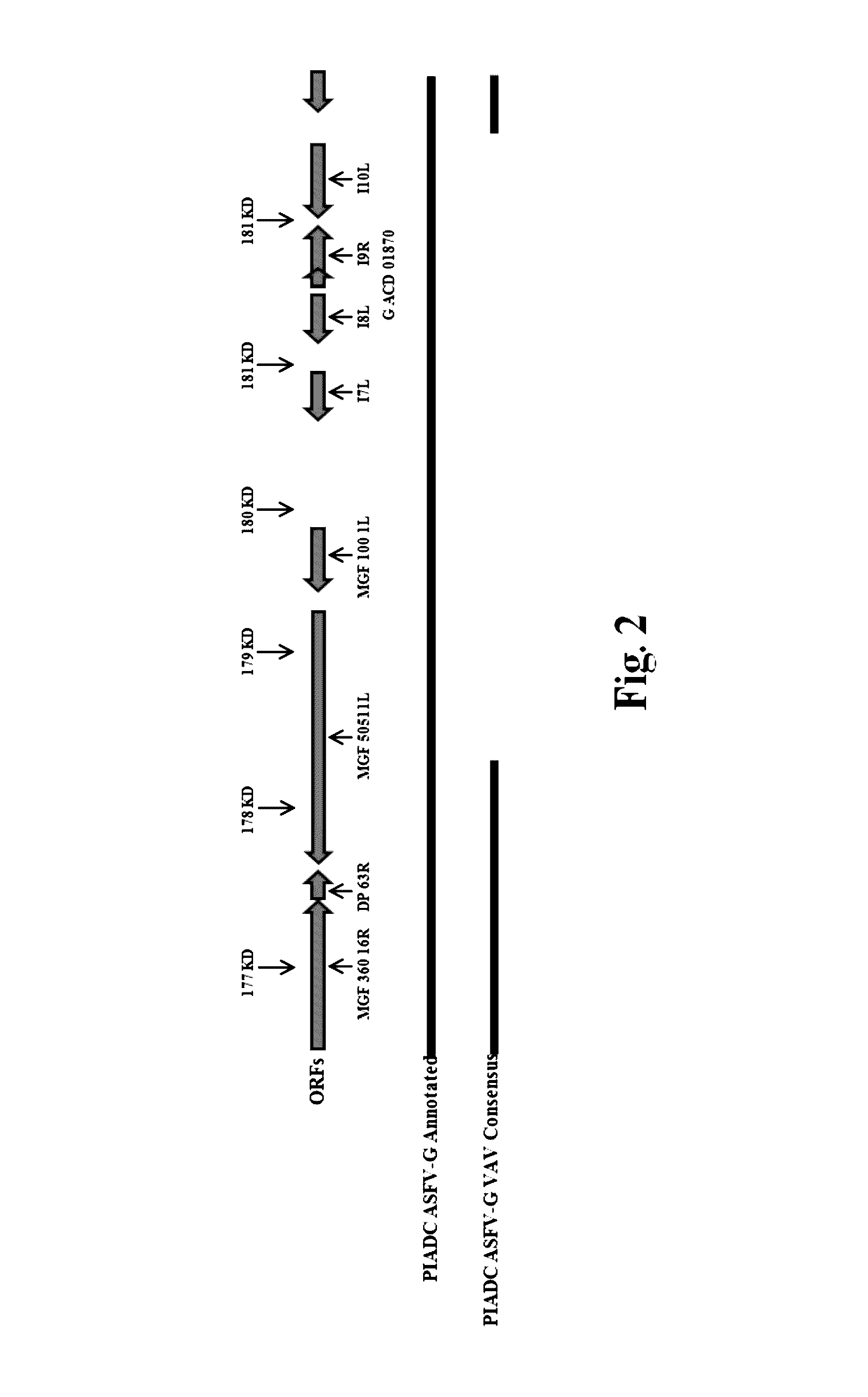African swine fever virus georgia strain adapted to efficiently grow in the vero cell line
a technology of vero cell line and swine fever virus, which is applied in the field of novel viruses of swine fever virus, can solve the problems of limiting pig production in the affected country, threatening food security, and major economic losses
- Summary
- Abstract
- Description
- Claims
- Application Information
AI Technical Summary
Benefits of technology
Problems solved by technology
Method used
Image
Examples
example 1
Viruses and Cell Cultures
[0040]The ASF virus Georgia strain was derived at PIADC from clinical material (spleen) of a field-infected pig kindly provided by Dr. Nino Vepkhvadze, from the Laboratory of the Ministry of Agriculture (LMA) in Tbilisi, Ga. The clinical material was macerated, resuspended in Dulbecco's Minimal Essential Media (DMEM) (Gibco, Grand Island, N.Y.) with 10% fetal calf serum (FCS) (Atlas Biologicals, Fort Collins, Colo.), clarified by centrifugation at 4° C., 20 min at 10,000 rpm and resuspended in Dulbecco's Minimal Essential Media (DMEM) (Gibco, Grand Island, N.Y.) with 10% fetal calf serum (FCS) (Atlas Biologicals, Fort Collins, Colo.). Vero cells were obtained from the ATCC, and sub-cultured in DMEM with 10% FCS. Growth kinetics was assessed either in Vero cells or in primary swine macrophage cell cultures prepared as described by Zsak et al. (1996, supra). Titration of ASFV from clinical samples was performed using primary swine macrophage cell cultures in 9...
example 2
Full Length Sequence of ASFV Georgia Vero Adapted Strain
[0041]ASFV DNA was obtained from the cytoplasm of infected cells using the trizol method. DNA concentration was determined using Qubit® dsDNA HS assay kit (Life Technologies) and read on Qubit® 2 Flourometer (Life Technologies). One ug of virus DNA was enzymatically fragmented to obtain blunt end fragments in a length range of 200-300 bp using Ion Shear™ Plus reagent kit (Life Technologies) and incubated at 37° C. in Peltier Thermal cycler DNA Engine Tetrad 2. After shearing, fragmented DNA library is loaded onto a high sensitivity DNA chip (Agilent) and analyzed using a 2100 Bioanalyzer (Agilent) to assess the library size distribution and confirm a fragment size range between 50-500 bp, with a peak around 200 bp. Then, fragmented DNA is ligated to Ion-compatible adapters and library barcodes, followed by nick-repair to complete the linkage between adapters and DNA inserts using Ion Plus Fragment Library kit (Life Technologies...
example 3
Development and Characterization of ASF-GVAV, the ASFV Georgia Vero-Adapted Strain
[0042]A spleen homogenate from a pig infected in the field with the Georgia strain of ASFV was used to infect a sub-confluent monolayer of Vero cells and incubated for 4 days in a 34° C. incubator. No evident cytopathic effect (CPE) or hemadsorption was detected. The cells were detached, sub-cultured then incubated for 4 days at 34° C. Again, no CPE or hemadsorption was detected. Infected cells were sub-cultured again under the same conditions. Six days later, the presence of several cell foci of rounded cells was observed. Infected cultures were subjected to immunohistochemistry using serum from an ASFV-infected pig, resulting in positive staining with evidence of virus spread in the Vero cells. The cell cultures were sub-cultured two additional times; CPE became widespread in the cultures. Cells were then scraped, centrifuged at low speed and the cell pellets were resuspended in fresh media and froze...
PUM
| Property | Measurement | Unit |
|---|---|---|
| temperature | aaaaa | aaaaa |
| Tm | aaaaa | aaaaa |
| temperatures | aaaaa | aaaaa |
Abstract
Description
Claims
Application Information
 Login to View More
Login to View More - R&D
- Intellectual Property
- Life Sciences
- Materials
- Tech Scout
- Unparalleled Data Quality
- Higher Quality Content
- 60% Fewer Hallucinations
Browse by: Latest US Patents, China's latest patents, Technical Efficacy Thesaurus, Application Domain, Technology Topic, Popular Technical Reports.
© 2025 PatSnap. All rights reserved.Legal|Privacy policy|Modern Slavery Act Transparency Statement|Sitemap|About US| Contact US: help@patsnap.com


